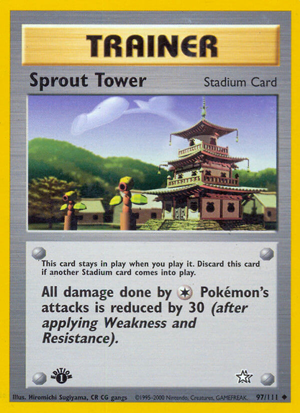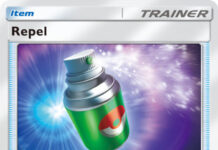
Sprout Tower – Neo Genesis
Date Reviewed: June 3, 2021
Ratings Summary:
Standard: N/A
Expanded: N/A
Ratings are based on a 1 to 5 scale. 1 is horrible. 3 is average. 5 is great.
Reviews Below:

Vince
I don’t think I had this card before when looking through some of the Pokémon collections my classmates in high school 10+ years ago.
Sprout Tower from Neo Genesis is a Stadium card that makes Colorless type Pokémon deal 30 less damage from attacks after applying Weakness & Resistance. This was a powerful card – under the right circumstances – back when damage output was pretty low, making most Colorless type Pokémon not deal little to no damage. Colorless weakness didn’t exist until EX Dragon, but by the time EX Dragon was released, Neo Genesis and few other sets after that were no longer Modified legal. Colorless resistance also exists, but was in the Diamond & Pearl series.
Effects like this…..makes Sprout Tower a situational card. If there were great colorless type attackers in their time, then Sprout Tower would definitely keep them in check. If not, then one would wish they used a different Stadium card.

Otaku
Sprout Tower (Neo Genesis 97/111) is a very old card, though it still feels somewhat new to me? Why? For old farts like me who began with Base Set, this was one of those newfangled, Gen II-inspired Stadium cards! While Stadiums debuted two sets prior, I also missed those two sets so… yeah, it was all pretty new to me still! As a Stadium card, Sprout Tower can be put into play, discarding any Stadium already there. In the present, you’re only allowed to play a single Stadium per turn and cannot play a Stadium if another with the same name is already in play. However, when Sprout Tower released, you could play as many Stadiums as you wanted during your turn.
Sprout Tower’s effect states that all damage done by attacks from [C] Pokémon is reduced by 30 after applying Weakness and Resistance. At the time, nothing was naturally Colorless Weak or Resistant, and I think there weren’t any combos that could create it. As it reduces the damage being done by Colorless Pokémon, that means the Pokémon receiving that damage can be yours, your opponent’s, Active, Benched, etc. -30 damage is a good-sized chunk now, equal to Resistance. It was even better back then; Resistance was -30 at the time as well but HP scores maxed out at 120. 120! Moreover, damage output was far lower; it was difficult to do more than 60 damage during your turn (which is why 70 HP used to be the “magic number”).
As a reminder, if you’re reading older articles, discussions, etc. from this period, “Standard” was used to describe the Unlimited Format and “Modified” was used to describe what we now call “Standard”. This was due to a misunderstanding somewhere in the pipeline; the original Standard (modern definition) was also an Unlimited Format, since everything was “new” and a rotating Format had yet to be implemented. “Standard” just refers to the default (standard) tournament Format. Sprout Tower was legal shortly after it released, which would have been for the Standard/Unlimited Format, as well as the 2001-2002 and 2002-2003 Modified (Standard) Formats.
During this period, we had some pretty impressive Colorless attackers. Just to name a few, there were Clefable (Jungle 1/64, 17/64; Base Set 2/130), Erika’s Jigglypuff , and Wigglytuff (Jungle 16/64, 32/64; Base Set 2 19/130). Plus the best card for utilizing Sprout Tower, Chansey (Base Set 3/102; Base Set 2 3/130)! Chansey would take 30 less from whatever Colorless attackers your opponent might be using, it would also do 30 less to itself with its “Double-Edge”. Neo Genesis also included the original version of Metal Energy. This was a Special Energy card, and its damage reducing effect worked for any Pokémon, not just [M] types. There was a drawback that was also later dropped; non-Metal Pokémon also did 10 less damage…
…leading to Steel Chansey decks! Double-Edge cost a massive [CCCC] to do 80 damage, and Chansey also did 80 to itself. The thing is, Chansey was one of the few Pokémon with 120 HP, and 80 OHKO’d some of the most popular Pokémon in the metagame. Slap one Metal Energy on Chansey, and its Double-Edge only did 70 damage to your opponent’s Active but the original Metal Energy’s effect meant Chansey only did 60 to itself: 10 less damage done and 10 less damage taken. With a full four Metal Energy attached, Chansey would do 40 to your opponent’s Pokémon without hurting itself at all and your opponent’s attacks were also doing 40 less damage.
Getting and keeping all four Metal Energy attached to a single Chansey was hard, but do able. Still, Sprout Tower offered an alternative. It was no where near as good of a deal, but doing 50 and 50 was still alright. With one Metal Energy, that became 40/30. Yes, that was still a solid deal with the damage output and HP scores of the day. It also helps that the deck could include cards like Gold Berry and (in Unlimited) Defender. Otherwise, Sprout Tower was a decent bit of TecH to include if decks relying on Colorless attackers were giving you grief in your local metagame. How would Sprout Tower do now? I’m not sure; overall, I think it would be a decent card but not overly good. After all, most competitive attackers are not Colorless.
Ratings
- Standard: N/A
- Expanded: N/A
We would love more volunteers to help us with our Card of the Day reviews. If you want to share your ideas on cards with other fans, feel free to drop us an email. We’d be happy to link back to your blog / YouTube Channel / etc. 😉
Click here to read our Pokémon Card of the Day Archive. We have reviewed more than 3500 Pokemon cards over the last 17+ years!



